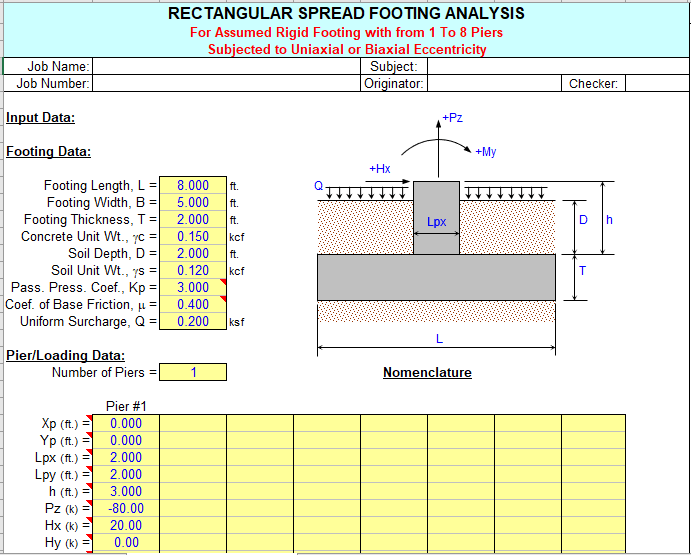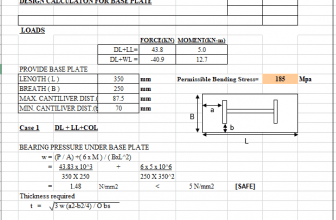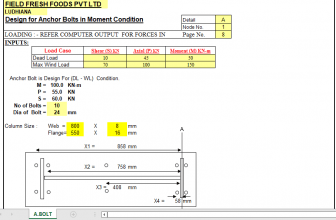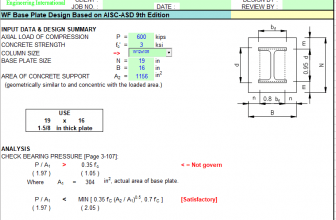
Program Description:
“FOOTINGS” is a spreadsheet program written in MS-Excel for the purpose of analysis of rigid rectangular
spread footings with up to 8 total piers, and for either uniaxial or biaxial resultant eccentricities. Overturning
sliding, and uplift stability checks are made when applicable, and resulting gross soil bearing pressures at
the four (4) corners of the footing are calculated. The maximum net soil bearing pressure is also determined.
This program is a workbook consisting of five (5) worksheets, described as follows:
Worksheet Name Description
Doc This documentation sheet
Footing (net pier loads) Individual rectangular spread footing analysis (with net pier loadings)
Footing (breakdown of loads) Individual rectangular spread footing analysis (with breakdown of loadings)
Footings (Table) Multiple rectangular spread footings analysis and design (table format)
Footings (Pier Table) Multiple rectangular spread footings – pier analysis (table format)
Program Assumptions and Limitations:
- This program assumes that the spread footing is in fact “rigid”, so that the bearing pressure is distributed
linearly on a homogeneous soil. (Note: the actual footing is generally not “rigid”, nor is the pressure beaneth
it distributed linearly. However, it has been found that solutions using the assumed “rigid” concept are
adequate and generally result in a conservative design.) - This program assumes an orthogonal X-Y-Z coordinate system with the origin located at the centroid of the
footing in plan (footprint). “Right-Hand-Rule” sign convention is used for input of all pier coordinates as
well as for all applied forces and moments at piers. - This program will handle from 1 up to eight (8) total piers located anywhere on the base of the footing.
Piers can be numbered in any desired order. - This program does not check the actual calculated soil bearing pressure against a given allowable soil
pressure. This is done so that the extent of acceptable overstress is left up to the judgement of the user.
However, in all cases this must be checked by the user. - This program does not use a specified permissible value for the factor of safety against overturning. However,
a minimum value of 1.5 to 2.0 is suggested, based upon the particular conditions. (A “Footing is unstable!”
error message will be displayed if the factor of safety against overturning is < 1.0. Then the user must revise
the footing dimensions or other parameters.) - This program does not use a specified permissible value for the factor of safety against uplift. However,
a minimum value of 1.2 to 1.5 is suggested, based upon the particular conditions and the extent of footing
confinement. (A “Footing is unstable!” error message will be displayed if the factor of safety against uplift is
< 1.0. Then the user must revise the footing dimensions or other parameters.) - The “Footing (net pier loads)” worksheet deals with net applied loadings at the piers. That is, there is no
allowance for individual breakdown of dead, live, and wind (or seismic) loadings.
This worksheet should be specifically used in any of the following conditions:
a. When the individual breakdown of loadings is not known or is not critical
b. When there are little or no uplift or overturning forces and moments due to wind (or seismic)
c. When the factor of safety against uplift or overturning due to wind (or seismic) is NOT critical
d. When there are overturning forces or moments due to only gravity (dead or live) loadings - The “Footing (net pier loads)” worksheet considers all net applied moments and horizontal loads as forces
causing overturning. However, a net uplift load is considered as a force causing overturning only when there is
an applicable resultant eccentricity in the direction of overturning. For a net uplift pier load, the “excess” pier
weight (pier weight less soil weight) is subtracted from the net uplift load at the pier location. - The “Footing (breakdown of loads)” worksheet allows for individual breakdown of dead, live, and wind (or
seismic) loadings.
This worksheet should be specifically used in any of the following conditions:
a. When the individual breakdown of loadings is known or is critical
b. When there are uplift or overturning forces and moments due to wind (or seismic)
c. When the factor of safety against uplift or overturning due to wind (or seismic) is critical
d. When there are no overturning forces or moments due to only gravity (dead or live) loadings - The “Footing (breakdown of loads)” worksheet considers only applied wind (or seismic) shears, uplifts, and
moments as forces causing overturning. Any wind (or seismic) loads which act in opposite direction to sense
of overturning are considered as forces which reduce the total overturning. Only applied pier dead (not live)
loadings are considered as forces resisting overturning. Any dead loadings which act in opposite direction to
sense of resisting overturning are considered as forces which reduce the total resistance to overturning. - This program includes the uniform live load surcharge in the calculation of the soil bearing pressures. The
uniform live load surcharge is not included in the calculation of “resisting” moment for overturning check, nor in
the calculations for uplift check. The uniform live load surcharge is assumed to act over the entire footing
plan area. - This program will calculate the soil bearing pressures at the corners of the footing for all cases of resultant
eccentricity, both uniaxial and biaxial. The corners of the footing are always designated in the footing plan
proceeding counterclockwise from the lower right-hand corner as follows:
(3) = upper left-hand corner (2) = upper right-hand corner
(4) = lower left-hand corner (1) = lower right-hand corner - Reference used in this program for footing with cases of biaxial resultant eccentricity is:
“Analytical Approach to Biaxial Eccentricity” – by Eli Czerniak
Journal of the Structural Division, Proceedings of the ASCE, ST4 (1962), ST3 (1963) - Another more recent reference for footing with cases of biaxial resultant eccentricity is:
“Bearing Pressures for Rectangular Footings with Biaxial Uplift” – by Kenneth E. Wilson
Journal of Bridge Engineering – Feb. 1997 - The “Footings (Table)” and “Footings (Pier Table)” worksheets enable the user to analyze/design virtually any
number of individual footings or footing load combinations. The footings must have only one concentric pier.
The footings may be subjected to biaxial eccentricities as long as 100% bearing is maintained. If one or more
corners become unloaded from biaxial eccentricities, then the error message, “Resize!” will be displayed.
Refer to those two worksheets for list of specific assumptions used in each. The column loads and footing/pier
dimensions input in rows “A” through “Q” of the “Footings (Table)” worksheet may be copied and pasted
(via “Paste Special, Values” command) into the same position in the “Footings (Pier Table)” worksheet. The
entire row of calculation cells can then be copied and pasted down the page to match the number of rows of
input in each of the two table format worksheets. - This program contains numerous “comment boxes” which contain a wide variety of information including
explanations of input or output items, equations used, data tables, etc. (Note: presence of a “comment box”
is denoted by a “red triangle” in the upper right-hand corner of a cell. Merely move the mouse pointer to the
desired cell to view the contents of that particular “comment box”.)





